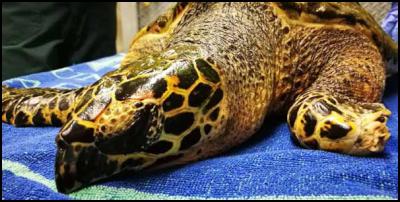Celebrating World Turtle Day
SEA LIFE Kelly Tarlton’s and Auckland Zoo celebrate World Turtle Day

Auckland – Tomorrow (Tuesday 23 May) marks World Turtle Day around the globe and to showcase the true meaning of the day, SEA LIFE Kelly Tarlton’s and Auckland Zoo vets have undertaken a medical check of a recently rescued, critically endangered Hawksbill turtle.
The juvenile turtle was found washed up on Northland’s 90 Mile Beach at the start of May. Marine turtles don’t breed on the beaches in New Zealand which means a turtle found on the beach is not well.
Following urgent medical attention from the Auckland Zoo vet centre, the hawksbill was then transported to SEA LIFE Kelly Tarlton’s rehabilitation centre where he is currently being monitored as part of a continuing partnership between the organisations.
Auckland Zoo Resident Vet Lydia Uddstrom said, “The Hawksbill came to us exhausted, dehydrated and not eating, with a well healed, amputated flipper. We took some x-rays to get a really good look at him and assess his flipper. We were unable to determine the cause of the injury but checked that his remaining bones were alright, which they were. It’s great to be able to provide the vet care for these endangered turtles and to work alongside the fantastic team at SEA LIFE Kelly Tarlton’s to help these ones back in to the ocean, but also help us learn more about them and how we can help them.”
The SEA LIFE Kelly Tarlton’s rehabilitation facility is the only facility in New Zealand that rehabilitates injured turtles and has successfully released over many turtles back to the wild.
Andrew
Christie, Kelly Tarlton’s SEA LIFE Aquarium Curator, is
pleased by the hawksbill’s progress so far: “While he
still has a long road to recovery ahead of him, he has made
an impressive turnaround in his short time at our
rehabilitation centre. We’re happy to share his story on
World Turtle Day – a day dedicated to the care,
conservation and awareness of one of the oldest living
reptiles in the world.”
The Kelly Tarlton’s team
has over 20 years’ experience in rescuing and
rehabilitating a range of endangered or near extinct sea
turtles in New Zealand. In partnership with the Department
of Conservation (DOC) and Auckland Zoo, being able to help
sick and injured marine life by nursing them back to good
health is making a real difference to the future of these
critically endangered species.
Sea turtles are one of the most affected by habitat loss, and are significantly impacted by plastic in the ocean. During his time at Auckland Zoo, the hawksbill passed plastic, which sea turtles often mistake for food in the ocean and eat. One way to make a difference is by reducing the use of plastic and disposing of it safely, which is vital for the survival of these turtles.
The hawksbill is expected to be on-site at Kelly Tarlton’s quarantine area for the next three to six months while the critical rehabilitation process is carried out. It is anticipated that he’ll be released to the public display in time for summer.
The stages of turtle rehabilitation:
1. The initial assessment takes place at Auckland Zoo – here, bloods are taken and the turtles are x-rayed and they are medically stabilised. This often means giving injectable fluids and other medication. They are slowly warmed up to a normal body temperature and are tube fed.
2. Once at SEA LIFE Kelly Tarlton’s, daily observations of physical state and behaviour continue - depending on the state of the turtle on arrival, this can occur as little as twice a day for healthier turtles or once an hour for those in a poor state
If the turtles are too weak to lift their heads, they’re set up in ‘trickle bins’ to help keep them warm - once warm and some energy is gained, turtles are then moved to a 2000L quarantine tank to continue their rehabilitation. It is imperative that the turtle is able to swim to the bottom of the tank.
3. Once the turtle is stable enough to be housed in the large quarantine tank, the first objective is to get it to feed. This usually takes a few weeks of offering food multiple times a day, either by hand or leaving it in the tank
4. Once the turtle has a good appetite, gained weight, resolved its buoyancy issues and finished any medication, the water in the tank is gradually cooled down over a few weeks to match the 1 million litre aquarium display water temperature (18.5-21°C)
5. The turtle will then stay in this tank until it’s fit for a wild release
The ‘Turtle Rescue Team’ encourages all
Kiwis to keep an eye out for distressed turtles close to
shore. If you find a marine turtle on the beach the best
thing to do is contact your local DOC office on 0800 DOC
HOT.
Ends
For more
information about SEA LIFE Kelly Tarlton’s many
conservation initiatives visit: http://www.kellytarltons.co.nz/protect/
and for more information about Auckland Zoo, visit: www.aucklandzoo.co.nz


 Hospice NZ: Sustainable Funding For Hospices
Hospice NZ: Sustainable Funding For Hospices David Hill - LDR: Surge In Young Parents’ College Enrolments
David Hill - LDR: Surge In Young Parents’ College Enrolments NZEI Te Riu Roa: School Lunches - Give Schools Option To Use In-School And Community Providers Immediately, Union Says
NZEI Te Riu Roa: School Lunches - Give Schools Option To Use In-School And Community Providers Immediately, Union Says University of Auckland: Billion-dollar Business Lessons From Kiwi Entrepreneur
University of Auckland: Billion-dollar Business Lessons From Kiwi Entrepreneur NZ Veterinary Association: NZVA Celebrates Welcome Additional Support From Veterinary Nurses
NZ Veterinary Association: NZVA Celebrates Welcome Additional Support From Veterinary Nurses Michael King Writers Centre: New Zealand’s National Writer-Residency Organisation Announces Its 2025 International Residency With Australia
Michael King Writers Centre: New Zealand’s National Writer-Residency Organisation Announces Its 2025 International Residency With Australia